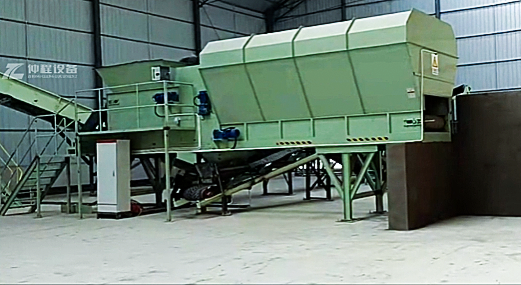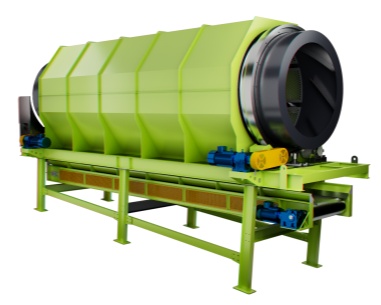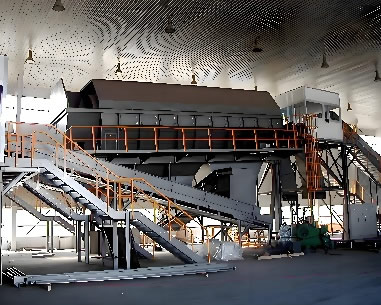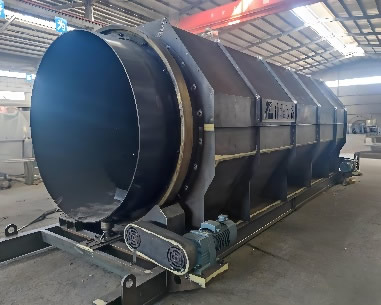
Five factors influencing the output of a drum screen.
-
Production Capacity:
80~200m³/h
-
Applicable Industries:
Recycling Plants/Waste Management/Composting Facilities/MSW
-
Power:
5.5-22kw
-
Core Components:
-
Place of Origin:
Henan, China
- Product Details
- Characteristics
- Working Principle and Application
- Parameters
Numerous factors influence the separation efficiency and output of a drum screen.
Screening is a widely used technique for categorizing solid particles based on size, but due to the pronounced heterogeneity and impurities found in solid waste, additional screening requirements arise. For instance, materials like construction waste and incineration slag often contain long, thin fibers and wires that can obstruct screen holes, thus impeding operational efficiency. The drum screen emerges as a reliable technology capable of both primary and final size screening.
The separation efficiency and output of the drum screen are predominantly influenced by five key factors:
1.Screen Hole Size:
The size of the screen holes determines what size particles can pass through. Smaller holes allow finer materials to pass, while larger holes allow coarser materials.
A smaller hole size can lead to higher separation efficiency for finer materials but might reduce throughput and increase the likelihood of clogging. Conversely, larger hole sizes might increase throughput but reduce separation efficiency for finer materials.
2.Drum Screen Diameter:
The diameter of the drum screen affects the screening surface area. A larger diameter provides more surface area for material to be screened.
Increasing the drum diameter can improve input efficiency by allowing more material to be processed at once. However, it might also require more power and space.
3.Rotation Speed:
The rotation speed of the drum affects the agitation and movement of the material being screened. Higher speeds typically result in more vigorous agitation.
Higher rotation speeds can increase input efficiency by enhancing the mixing and screening action. However, excessively high speeds can lead to material bouncing off the screen surface, reducing separation efficiency.
4.Baffle Type and Number:
Baffles are internal structures within the drum screen that help control the flow of material and promote agitation.
The type and number of baffles influence the flow pattern and agitation intensity within the drum. Well-designed baffles can enhance input efficiency by ensuring uniform distribution of material across the screen surface and promoting effective screening. They can also improve separation efficiency by facilitating the stratification of particles.
5.Drum Inclination:
The inclination or angle of the drum screen affects the residence time of material on the screen surface and the trajectory of particles.
An inclined drum allows for longer residence times, which can improve separation efficiency by allowing finer particles more time to pass through the screen. However, excessively steep inclinations can cause material to slide too quickly, reducing input efficiency.
-
01Available in various sizes and configurations to suit different scales of operation, from small facilities to large industrial plants.
-
02Capable of handling a wide range of materials, including construction waste, domestic waste incineration slag, and other heterogeneous solid wastes.
-
03Adjustable Screen Hole Size: Available with different screen hole sizes to accommodate various material types and separation requirements. Variable Rotation Speed: Adjustable rotation speeds to optimize screening efficiency and throughput for different materials.
-
04Easy Maintenance Access: Designed with features that allow for easy access for cleaning, maintenance, and repairs, minimizing downtime.
Working Principle of Drum Screens
Material Feeding:
The material is fed into the drum screen through a hopper or conveyor.
Rotating Drum:
The drum, which is a cylindrical screen, rotates around its axis. The rotation can be driven by an electric motor and gearbox.
Screening Action:
As the drum rotates, the material inside tumbles and cascades. This action causes finer particles to fall through the screen holes, while larger particles continue to move along the drum's length.
Separation:
Particles that are small enough pass through the holes in the drum screen and are collected as the screened product. Larger particles are conveyed to the end of the drum and discharged as oversize material.
Internal Baffles:
Internal baffles within the drum can help to mix and agitate the material, ensuring more effective screening and preventing clogging of the screen holes.
Drum Inclination:
The drum is often inclined at a slight angle. This inclination, combined with the rotating action, moves the material through the drum.
Applications of Drum Screens
Waste Management:
Used in the processing of municipal solid waste, construction and demolition waste, and industrial waste to separate materials based on size and remove impurities.
Recycling:
Employed in recycling plants for the classification and separation of recyclable materials such as metals, plastics, and glass.
Mining and Quarrying:
Applied in mining operations to separate valuable minerals from ore, and in quarries for separating different grades of aggregate.
Agriculture:
Utilized for the sorting of agricultural products like grains, seeds, and vegetables, ensuring uniformity in size.
Composting:
Used in composting facilities to screen compost material and remove unwanted debris, ensuring a high-quality end product.
Food Processing:
Employed in the food industry to sort and grade various food products, including fruits, vegetables, and nuts.
Pharmaceuticals:
Used in the pharmaceutical industry for the precise separation and classification of different ingredients and products.
Forestry:
Applied in the forestry industry for screening wood chips, sawdust, and other wood-based materials.
Chemical Industry:
Used for the classification and separation of chemicals and raw materials in various chemical processes.
| Model | Length Range | Segment No. | Aperture Size | Power (Kw) | Inclined Angle | Max. Material Size | Rotating Speed(rpm) |
| ZCφ600 | 2-4m | 1-2 | ≤30mm | 2.2-3 | 0-7° | 60mm | 12-18 |
| ZCφ800 | 2-5m | 1-3 | ≤50mm | 3-5.5 | 0-7° | 100mm | 12-18 |
| ZCφ1000 | 2-6m | 1-4 | ≤100mm | 4-11 | 0-7° | 150mm | 10-18 |
| ZCφ1200 | 3-8m | 1-4 | ≤150mm | 5.5-18.5 | 0-7° | 200mm | 9-15 |
| ZCφ1500 | 3-10m | 1-5 | ≤200mm | 7.5-22 | 0-7° | 250mm | 9-15 |
| ZCφ1800 | 4-12m | 1-5 | ≤220mm | 7.5-22 | 0-7° | 270mm | 8-15 |
| ZCφ2000 | 5-15m | 1-5 | ≤250mm | 11-30 | 0-7° | 300mm | 8-12 |
| ZCφ2500 | 5-18m | 1-6 | ≤300mm | 11-30 | 0-7° | 350mm | 8-12 |
customized according to your requirements
-
 Drum screen garbage processing machine for msw recyclingManaging municipal solid waste (MSW) efficiently is crucial for urban areas. Drum screen garbage processing machines are a game-changer in this field. They ensu...Get Quote
Drum screen garbage processing machine for msw recyclingManaging municipal solid waste (MSW) efficiently is crucial for urban areas. Drum screen garbage processing machines are a game-changer in this field. They ensu...Get Quote -
 Wind Separator Technology for Lightweight Materials in Urban Solid Wastewind separator, also known as air separation, is a sophisticated and efficient method of sorting that utilizes air as the separating medium.Get Quote
Wind Separator Technology for Lightweight Materials in Urban Solid Wastewind separator, also known as air separation, is a sophisticated and efficient method of sorting that utilizes air as the separating medium.Get Quote -
 Five factors influencing the output of a drum screen.The input efficiency and separation efficiency of the drum screen are controlled by the screen hole size, drum screen diameter, rotation speed, baffle type and ...Get Quote
Five factors influencing the output of a drum screen.The input efficiency and separation efficiency of the drum screen are controlled by the screen hole size, drum screen diameter, rotation speed, baffle type and ...Get Quote -
 Garbage screening drum screenTrommel screen is consisting of five parts: drum, frame, hopper, reducer and motor.After the material goes into the drum, it is screened along with the rotation...Get Quote
Garbage screening drum screenTrommel screen is consisting of five parts: drum, frame, hopper, reducer and motor.After the material goes into the drum, it is screened along with the rotation...Get Quote




